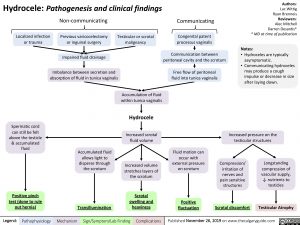Hydrocele: Pathogenesis and clinical findings Non-communicating
Communicating
Congenital patent processus vaginalis
Communication between peritoneal cavity and the scrotum
Free flow of peritoneal fluid into tunica vaginalis
Authors: Luc Wittig Ryan Brenneis Reviewers: Alec Mitchell Darren Desantis* * MD at time of publication
Notes:
• Hydroceles are typically asymptomatic.
• Communicating hydroceles may produce a cough impulse or decrease in size after laying down.
Localized infection or trauma
Previous varicocelectomy or inguinal surgery
Impaired fluid drainage
Imbalance between secretion and absorption of fluid in tunica vaginalis
Testicular or scrotal malignancy
Spermatic cord can still be felt
above the testicle & accumulated fluid
Accumulation of fluid within tunica vaginalis
Hydrocele
Increased scrotal fluid volume
Increased volume stretches layers of the scrotum
Scrotal swelling and heaviness
Increased pressure on the testicular structures
Accumulated fluid allows light to
disperse through the scrotum
Fluid motion can occur with
external pressure on scrotum
Positive fluctuation
Compression/ irritation of nerves and pain sensitive structures
Scrotal discomfort
Longstanding compression of vascular supply, ↓ nutrients to testicles
Positive pinch test (done to rule out hernia)
Transillumination
Testicular Atrophy
Legend:
Pathophysiology
Mechanism
Sign/Symptom/Lab Finding
Complications
Published November 26, 2019 on www.thecalgaryguide.com

